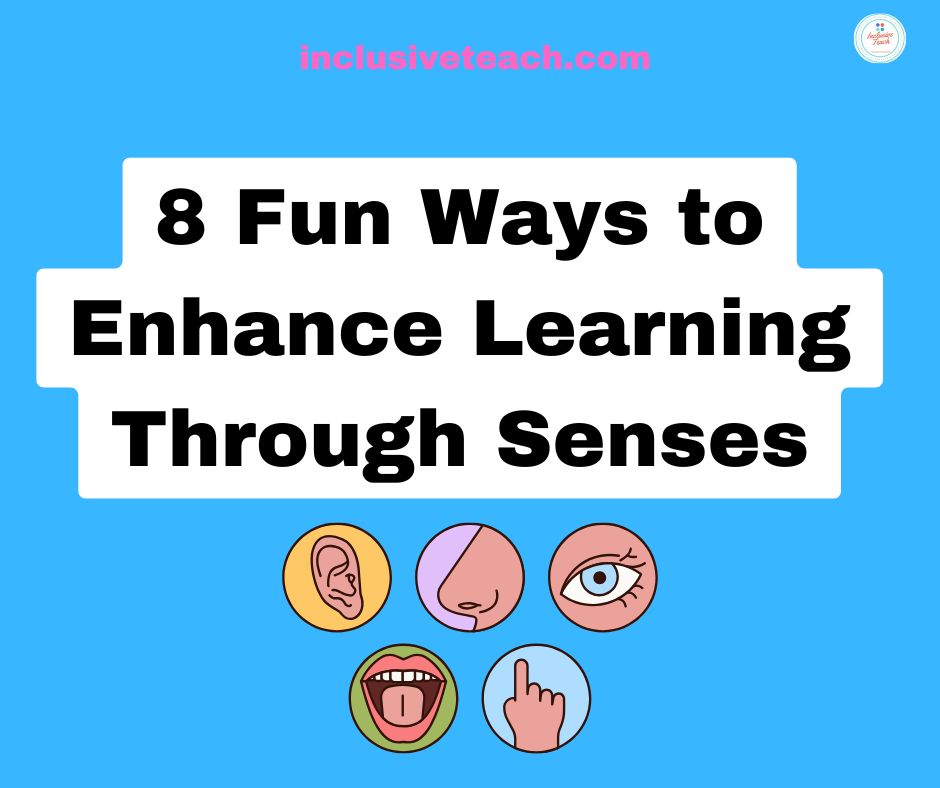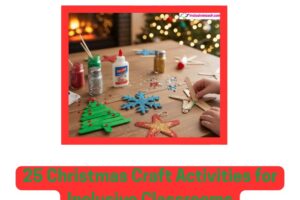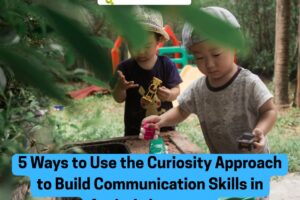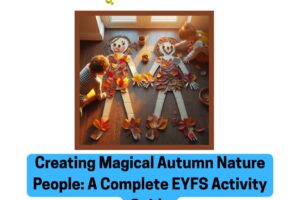
8 Fun Ways to Enhance Learning Through Senses
8 Multi-Sensory Learning Ideas for Any Subject
Let’s be honest, for many of us, school was a largely visual and auditory affair. Sit down. Look at the board. Listen to the teacher. Read the book. Repeat. And for some students, this traditional approach works perfectly. But what if your brain isn’t wired to learn best by simply looking or listening? What if it craves movement, touch, or even a different smell to truly ‘get’ a concept?
That’s where Multi-Sensory Learning (MSL) sweeps in like a superhero. Forget rote memorisation and passive listening. MSL is about engaging as many senses as possible – sight, sound, touch, movement, and even taste or smell (safely, of course!) – to make learning stick, transforming abstract ideas into concrete, memorable experiences. Who knew history could be so… squishy? Welcome to multi-sensory magic!
It’s not just for children with identified Special Educational Needs; MSL benefits every learner, strengthening neural pathways and deepening understanding for all. So, if you’re ready to make learning less about ‘sit still and listen’ and more about ‘explore and discover,’ here are eight fantastic multi-sensory ideas you can weave into any subject, whether you’re a teacher in a bustling classroom or a parent at the kitchen table.

1. The Tactile Toolkit: Hands-On Learning, Literally
What it is: Bringing learning to life through touch and manipulation. This is about making concepts tangible and giving busy hands a job.
Sensory Systems Targeted: Tactile, Proprioceptive, Visual.
Subject Examples:
- Literacy: Use sandpaper letters or alphabet puzzles with raised textures to learn letter shapes and sounds. Form letters from play dough or pipe cleaners.
- Maths: Count with textured objects like beans, large buttons, or unifix cubes. Learn fractions by physically cutting up and handling paper shapes or even actual food (safely!).
- Science: Explore different materials by touch (smooth, rough, bumpy, squishy). Use sensory bins filled with rice, lentils, or water beads to find hidden objects related to a topic (e.g., small plastic animals for a habitat study).
Top Tip: Keep a basket of varied textured items easily accessible. A child exploring different fabrics isn’t ‘fidgeting’ aimlessly; they might be regulating themselves to listen better!
2. Movement Masterclass: Learning on the Go
What it is: Integrating physical movement directly into academic tasks, leveraging the body’s need for action to enhance cognitive processing.
Sensory Systems Targeted: Vestibular, Proprioceptive, Kinesthetic, Visual, Auditory.
Subject Examples:
- Literacy: Create a ‘word hopscotch’ where children jump to different squares to spell out words or identify phonics sounds. Act out vocabulary words or scenes from a story.
- Maths: Practice times tables by bouncing a ball for each answer. Create a giant number line on the floor and have children walk/jump to solve addition or subtraction problems.
- Geography: Create an ‘obstacle course’ representing a journey or terrain, encouraging different movements (crawling under, jumping over, balancing).
Top Tip: Short, intentional movement breaks can re-energise a flagging brain. It’s not about stopping learning; it’s about shifting gears to optimise it.
3. Auditory Adventures: Listening Beyond the Loudness
What it is: Using sound and rhythm in creative ways to reinforce learning, beyond just spoken instruction.
Sensory Systems Targeted: Auditory, Kinesthetic, Visual (if paired with visual aids).
Subject Examples:
- Literacy: Clap out syllables in words. Learn spelling rules through memorable songs or chants. Record themselves reading a passage and listen back.
- Maths: Create rhythmic songs for counting or times tables. Use different instruments or sounds to represent numbers or mathematical operations.
- History: Listen to historical speeches, era-specific music, or soundscapes that evoke a particular time period.
Top Tip: For children with auditory processing difficulties, simplify verbal instructions by breaking them into smaller chunks or pairing them with visual cues. Sometimes, silence is the best sound.
4. Visual Vibrancy: More Than Just Pictures
What it is: Making information pop with colour, clear structures, and dynamic visual aids that capture and direct attention.
Sensory Systems Targeted: Visual.
Subject Examples:
- All Subjects: Use visual schedules and visual timers to help children understand routines and manage their time. Colour-code notes or instructions.
- Literacy: Use Anchor charts or colourful graphic organisers to plan essays. Highlight different parts of speech in different colours.
- Science: Create detailed diagrams using bright colours, or watch engaging educational videos that visually demonstrate complex processes.
- History: Use timelines with clear pictures, icons, and colour-coded events. Create mind maps with strong visual links.
Top Tip: Avoid visual clutter! A few impactful, well-placed visuals are far more effective than an overwhelming explosion of posters. Less is often more for sensitive eyes.
5. Oral Motor Magic: Learning Through Chewing & Blowing
What it is: Engaging the mouth and jaw to provide regulating input, which can surprisingly improve focus and calm.
Sensory Systems Targeted: Oral Motor, Proprioceptive, Gustatory.
Subject Examples:
- All Subjects: For children who crave oral input, allow access to safe, chewable items like ‘chewelry’ (silicone necklaces or bracelets designed for chewing) during quiet work times.
- Literacy: Practice blowing bubbles or whistles to strengthen oral motor muscles important for speech articulation and breath control while reading aloud.
- Sensory Breaks: Offer crunchy snacks (like carrot sticks or pretzels) or chewy sweets (if allowed) during designated snack times, as the chewing provides organizing input.
Top Tip: This is about providing an appropriate outlet, not distracting them with food. It’s often a very discreet way for a child to self-regulate without even realising it.
6. Olfactory & Gustatory Experiences: Scenting & Tasting the Lesson
What it is: Incorporating safe, non-toxic scents and tastes into learning activities (with strict allergy awareness!) to create strong memory anchors.
Sensory Systems Targeted: Olfactory, Gustatory, Memory.
Subject Examples:
- Science: Explore different natural scents when learning about plants (e.g., rosemary, mint, lavender). Conduct safe experiments involving simple tastes (e.g., sweet, sour, salty solutions).
- History/Geography: Discuss the smells associated with different historical periods (e.g., spices, woodsmoke) or geographical regions. If safe and appropriate, bring in simple, culturally relevant foods to taste.
- Storytelling: Use scented playdough or scratch-and-sniff stickers to add another dimension to narratives.
Top Tip: Always, always be mindful of allergies, sensitivities, and safety protocols. Use only mild, natural scents, and ensure any edible items are cleared with parents beforehand.
7. Vestibular Adventures: Rocking, Rolling, and Regulating
What it is: Using movement that stimulates the balance system to help children organise their bodies and minds.
Sensory Systems Targeted: Vestibular, Proprioceptive, Kinesthetic.
Subject Examples:
- All Subjects: Allow students to use wobble cushions or rocking chairs during seated work. Integrate short bursts of spinning, swinging (if equipment is available), or rocking during sensory breaks.
- Literacy/Maths: Recite poems or times tables while gently swaying or rocking.
- Circle Time: Use gentle swaying or rocking motions during calming group activities to promote regulation and attention.
Top Tip: Ensure movements are safe and supervised. Some children crave fast movement, others prefer slow and rhythmic. Observe your child’s reactions to gauge what’s ‘just right’ for them.
8. The Sensory Story: Immersive Narratives
What it is: Creating stories that engage multiple senses simultaneously through props, sounds, and tactile experiences as the narrative unfolds.
Sensory Systems Targeted: All senses, plus Auditory and Visual for the story itself.
Subject Examples:
- Literacy/History: When reading about a storm, use a fan (wind), a water spray bottle (rain), and crinkled paper (thunder). When exploring a historical period, incorporate relevant textures (rough cloth for medieval times), smells (spices for exploration), and sounds.
- Science: For a story about the rainforest, use real leaves, a spray bottle, rainforest sounds, and maybe even a gentle fan.
- Emotional Literacy: Use sensory items to represent different emotions in a story (e.g., a scratchy fabric for anger, a soft blanket for comfort) to help children connect physical sensations to feelings.
Top Tip: Keep the story simple, the props safe and easily manageable, and involve the child as much as possible in interacting with the sensory elements.
The Multi-Sensory Difference: A Fuller World of Learning
Embracing Multi-Sensory Learning isn’t about adding ‘more’ to your plate; it’s about seeing the learning process with fresh eyes and offering different pathways to understanding. It acknowledges that every brain learns uniquely and brilliantly. By engaging more of the senses, we’re not just making lessons more fun (though that’s a welcome bonus!); we’re making them more accessible, more memorable, and ultimately, more effective for every child. So, go forth, experiment, and enjoy the wonderful, squishy, noisy, vibrant world of multi-sensory learning!

Related
Discover more from Special Education and Inclusive Learning
Subscribe to get the latest posts sent to your email.
Source link



